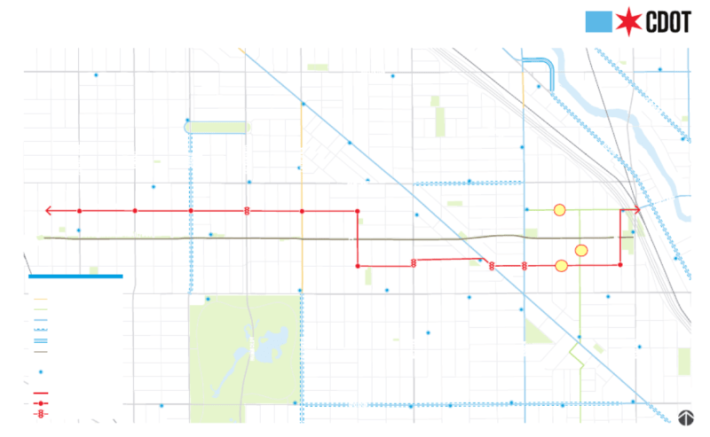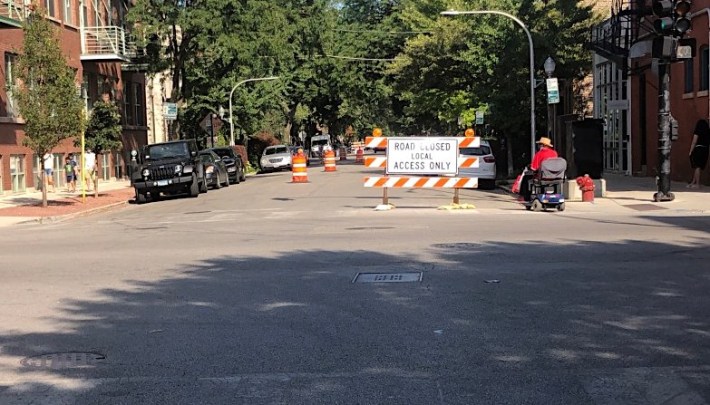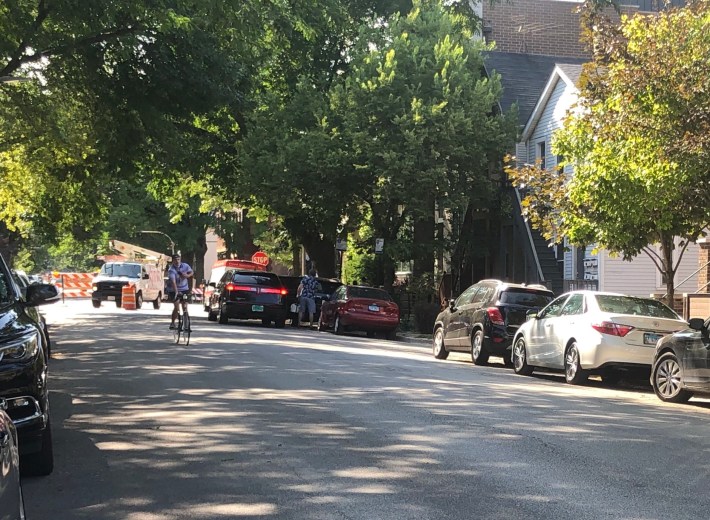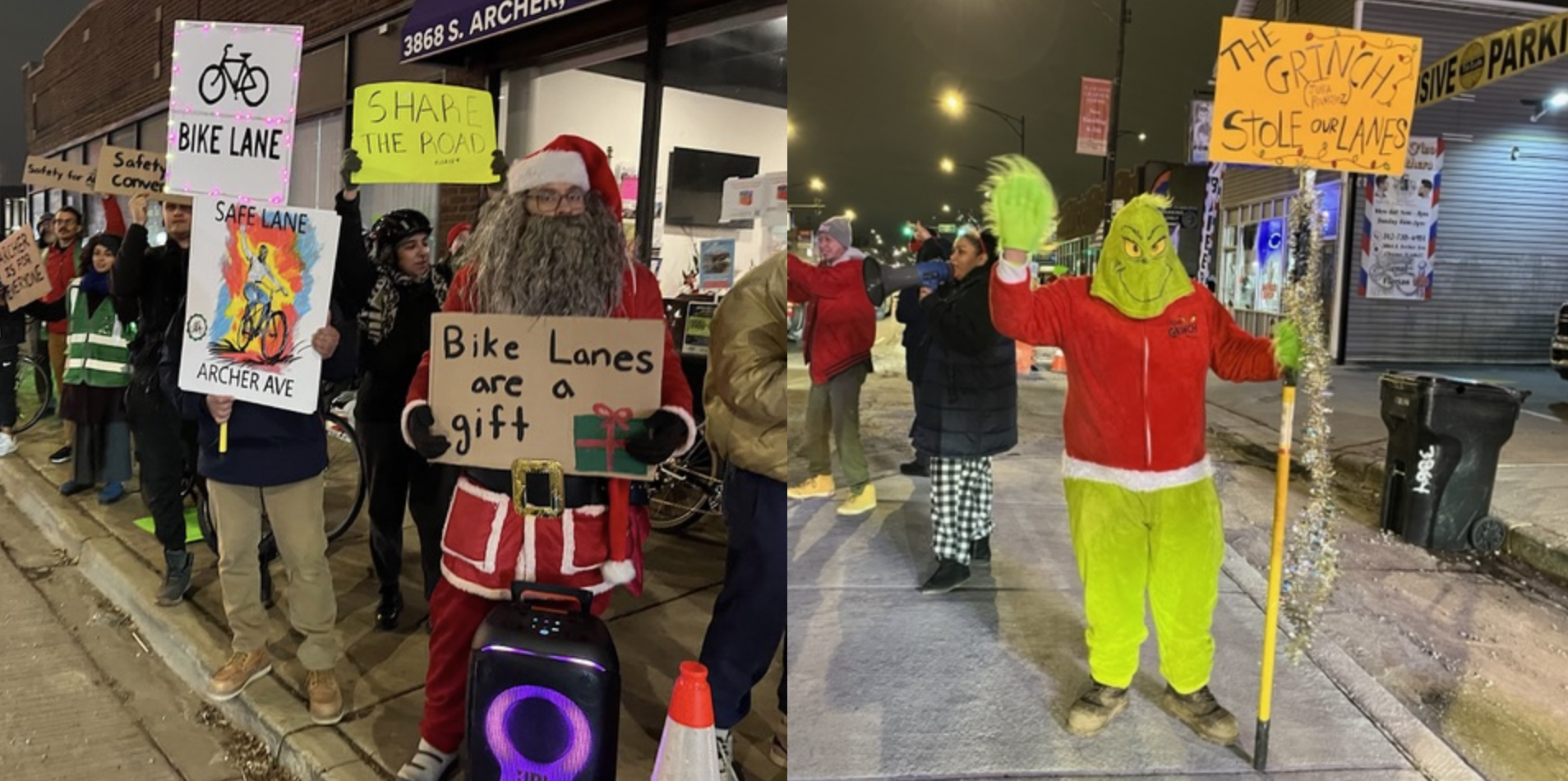Update: 8/25/20, 3:15 PM: First Ward chief of staff Allison Carvalho provided the following statement about why the western third of the Cortland/Wabansia Slow Street was removed and the traffic barrels were relocated to the eastern portion:
We had over 40 residents reach out around the [Slow Street] via email and phone. Half of the emails came from residents who live east of Humboldt and expressed approval / excitement of the Slow Street, but mentioned persistent issues with construction trucks, lack of signage and barrels and a need for increased enforcement/monitoring from the Chicago Department of Transportation. The other half of the emails came from both cyclists and residents west of Humboldt. Residents consistently expressed that they did not see a reason for the Shared Street given that The 606 was open and that the Shared Street caused issues with parking and driving. Cyclists west of Humboldt described persistent issues with aggressive drivers, barrels being knocked down or moved and not feeling safe walking or riding. We relayed those concerns to the Chicago Department of Transportation and given their capacity at this time, they found that it would be more effective to redistribute resources to ensure the Shared Street could be as effective as possible.
Asked what will be done to address aggressive driving West of Humboldt, Carvalho declined to comment. Streetsblog will asking CDOT this question as well.
Last week the Chicago Department of Transportation took down the Dickens Avenue Slow Street (the city calls them "Slow Streets") in Lincoln Park to facilitate driving, despite the fact the the corridor had gotten great use from pedestrians and cyclists and had a perfect safety record.
Over the weekend CDOT dismantled part of another popular Slow Street on Cortland Street and Wabansia Avenue in response to feedback from residents and use data the department collected. The corridor treatment was installed on June 12 as an alternative to the Bloomingdale Trail, which had been closed since late March, although the trail reopened ten days after the Slow Street debuted.
The Slow Street originally ran between Ashland and Lawndale avenues along Marshfield Avenue, Wabansia, Rockwell Avenue, and Cortland. CDOT took down the westernmost section between Lawndale and Humboldt, roughly a third of the total length of the corridor. On the bright side the barricades and traffic barrels that were removed were redeployed on the stretch between Humboldt and Milwaukee Avenue, which CDOT says has seen more use by people walking, jogging, and biking, as well as higher motor vehicle traffic volumes.

I went out Saturday afternoon around 4 p.m. to check out the new Slow Street layout and check in with users. There weren’t a lot of people using the street on foot or bike at the time, possibly because it was hot out, with a high of 90 degrees Fahrenheit, but I did talk to a few residents.
Jose Sanchez and Lisette Lebron were using dockless electric scooters on Wabansia near Leavitt. The Slow Street is "OK," Sanchez said. "There are fewer cars but it’s still not totally stress free. We like using the 606 but sometimes it’s too crowded so we use this street instead.”
Lebron said she’s found the Slow Street “challenging to navigate as a driver, but it’s worth it because it makes the street safer for everyone else.” Asked how she likes Chicago's latest scooter pilot, she replied “It’s like a video game. You’re trying to avoid potholes and cracks in the street and avoid getting hit. It’s still a fun way to get around but the [condition of the streets] make it hard.”

A block further west at the T-bone intersection of Wabansia and Oakley Avenue, which has stop signs in both directions, two drivers navigated a road closure sign awkwardly but considerately. The first motorist was heading east on Wabansia, stopped at the junction, and then accelerated slowly in order to allow the other driver turning west from from Oakley to enter Wabansia. However, I witnessed other drivers take sharp turns to compensate for the road closure signs.
Some Slow Street users have noted that the orange traffic barrels CDOT uses are a particularly effective traffic calming device. On some blocks motorists were driving more slowly around them, and on other blocks the barrels were placed closer to parked cars, which doesn’t do much to slow down drivers. I moved one of the barrels back to the middle of the street. Still, it would be easier for the next disgruntled driver to push it back against the parking lane again.
On a block that had two or three barrels on it and street closure signs at both ends, I saw a family loading a car. One of the parents warned the children not to go into the street because a driver was approaching. This interaction between a parent and a child made it clear that traffic barrels alone are not enough to keep people safe. In an ideal world every residential street would be designed so motorists are fully aware they are guests, and so that it's physically difficult to speed. We have a long way to go to reach this reality.

Slow Streets are a step in the right direction for calming traffic and getting people to rethink how we use residential roadways. But we need more aggressive measures to get drivers to slow down and to create streets that prioritizes people walking and cycling. We need to advocate for this bolder vision for our transportation landscape, and push City Council to pass a 2021 budget that will help pay for more walking and biking infrastructure.
Follow Courtney Cobbs on Twitter at @CourtneyCyclez




